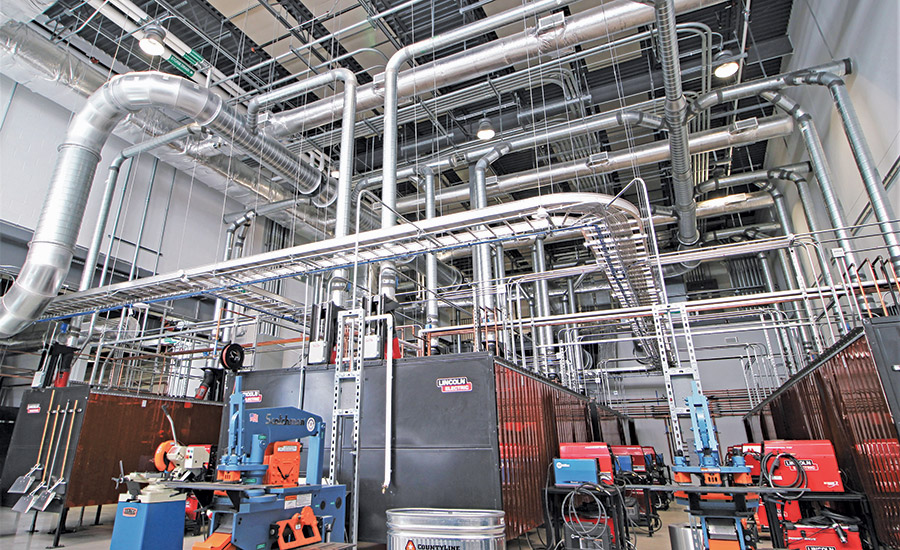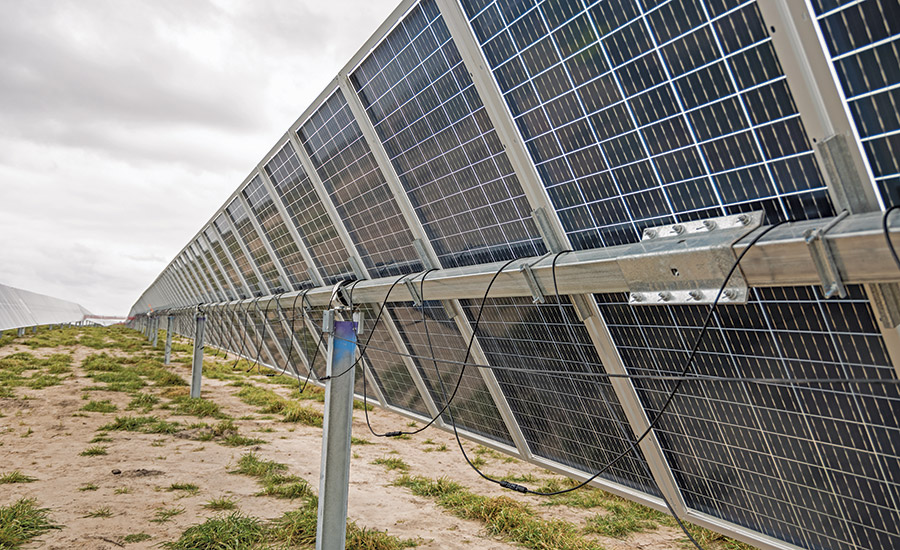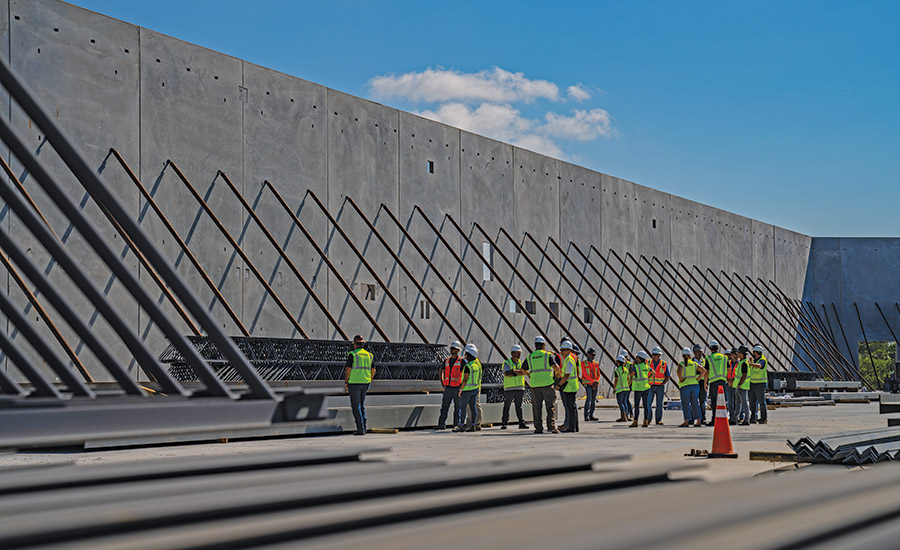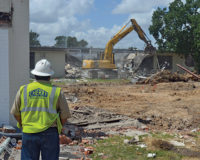While work continues to be plentiful for specialty contractors across the five-state region of Arkansas, Louisiana, Mississippi, Oklahoma and Texas, concerns remain for how the project landscape will continue to evolve as the impacts of the COVID-19 pandemic continue to weigh on the world.
In 2020, the top 25 specialty contractors on ENR Texas & Louisiana’s annual Top Specialty Contractors ranking reported a combined $7.35 billion in revenue across the region, down $2.27 billion from the $9.62 billion reported by the top 25 specialty contractors on last year’s ranking.
“Construction starts have hit a rough patch following the euphoria seen in the early stages of recovery from the pandemic,” Richard Branch, chief economist for Dodge Data & Analytics, said in a September report. “The Delta variant has raised concern that the fledgling economic recovery is stalling out, undermining the already low level of demand for most types of nonresidential buildings. Additionally, significant price increases for construction materials, logistic constraints and labor shortages are making a challenging situation worse. Construction starts are likely to remain unsteady over the next few months. However, the dollar value of projects entering planning continues to suggest that the recovery in construction starts should resume early in the new year.”
|
Related Link |
In August, total construction starts fell 9% to a seasonally adjusted annual rate of $782.8 billion, Dodge Data & Analytics reported Sept. 20, marking an 11-month low for project starts across the U.S.
“With the industry as a whole, the pandemic produced a big shift in material escalation as well as hesitancy to start new projects,” adds Erik Kluetz, director of corporate communications at Walker Engineering.
Although the Irving, Texas-based firm saw an $81.6 million decline in regional revenue for 2020 over 2019, Walker rose three spots to No. 4 on this year’s ENR Texas & Louisiana Top Specialty Contractors ranking with $350.4 million in regional revenue.
“We were able to retain most of our key personnel through the pandemic while adjusting field labor based on project demand,” Kluetz says.
Walker’s DFW Electrical division completed its scope of work on the Collin College Technical Campus in Allen, Texas, at the end of 2020. Walker performed all electrical installations including electrical distribution, interior lighting, exterior lighting, lighting controls and emergency back-up generator installation.

Walker Engineering performed all electrical installations on the Collin College Technical Campus in Allen, Texas. Shown above is the school’s welding shop.
Photo courtesy of Walker Engineering
Another project that wrapped up at the end of 2020 was the Methodist Midlothian Medical Center, a five-story bed tower and two-story office building set in Ellis County. Walker’s DFW Network Services division completed a scope of work that included cable tray and support, horizontal cabling, low-voltage cabling, backbone and security cabling with 2,500 data drops throughout the hospital and medical office building.
Meanwhile, Power Design, St. Petersburg, Fla., recorded a $20.5 million gain in regional revenue, which boosted the firm up three spots to No. 19 on the ranking with $115 million in regional revenue. Lauren Permuy, senior vice president of business development, credits Power Design’s tech-forward culture, which laid the groundwork for a strong, collaborative office-to-field relationship ahead of the pandemic.
“By utilizing strategic applications such as crew connect—an internally developed application that manages and engages labor—and capitalizing on our ability to work in a virtual design environment, we were able to remain successful through the pandemic,” Permuy says.
The firm also adopted OpenSpace Technology at full capacity over the last year.

Rosendin’s renewable energy group is leading work on the Aktina Renewable Power Project, the largest solar power project in southeastern Texas.
Photo courtesy of Rosendin
“We used this hardhat-mounted technology on a smaller scale prior to the pandemic but implemented it on all projects upon COVID-19’s onset,” she says.
“This allowed our teams to virtually walk projects and check out the progress—some jurisdictions even leveraged our technology for virtual inspections.”
Recent major projects include the 600 Guadalupe Street mixed-use high rise in Austin and the Atelier, another mixed-use high rise located in Dallas. Projects in Houston included two multifamily residential high-rise towers: Block 42 and Block 98 (Discovery Tower).
“We’re growing in ways that accommodate industry demand and our partners’ needs, expanding into additional geographies—most recently Washington and Arizona—and simplifying our project delivery as technology integration increases,” Permuy says.
Prefabrication has become an integral part of Power Design’s supply strategy and is being used on its new 200,000-sq-ft distribution facility opening late this year.
Pflugerville, Texas-based Rosendin posted a $31 million gain in regional revenue for 2020 over 2019, which bumped the firm up two spots to No. 15 on the Top Specialty Contractors ranking with $174 million in revenue. The firm’s division manager Shaun Mahan links that growth to the fact that Texas is growing.
“We saw little effect from the pandemic on work being done. Very few builds were stalled or canceled, and many of the builds had already procured bank funding before the pandemic,” he says.
Solar energy is a new initiative for Rosendin. The firm’s renewable energy group began construction in June on the 500-MWac/631-MWdc Aktina Renewable Power Project, which will include installation of 1.4 million solar modules across 4,000 acres in Wharton County, located outside the Houston area.
Other ongoing projects include the University of Texas at Austin’s Welch Hall renovation, which will modernize aging science facilities, as well as the Del Mar Community College South Campus project, which includes construction of a new central plant for a greenfield campus.
Fort Worth-based Cummings Electrical saw a $36 million gain in regional revenue for 2020, pushing the firm up two spots to No. 11 with revenue of $216 million.
“There are also concerns about the lack of resources that the construction industry is facing across the country.”
—Shaun Mahan, Division Manager, Rosendin
“We had some great projects that came in during the first quarter of 2020 as well as some backlog that was released. We were blessed to be in a strong financial position when the pandemic started,” says Christine Matthews, communications manager at Cummings. “Increases in commodity and material pricing as well as the pandemic itself has strongly characterized 2020-2021 for us, just as it has for everyone. In addition, loss of efficiency on project sites due to COVID protocols and loss of revenue due to delays has been hard on the local workforce, projects and the construction industry overall.”
The firm continues to be awarded work in its primary sectors of health care, data centers, mixed-use, office, hospitality and multifamily. Recently completed work in the Dallas-Fort Worth area includes the AMLI Residential Tower, the Legacy Midtown Park Senior Center and the Texas Christian University School of Music. Cummings’ team is currently at work on the Medical City Dallas electronic performance support system power renovations and the Omni PGA Frisco Resort in Frisco, Texas.
“We have used this time during the pandemic to develop more efficient internal processes to support our strategy to create value and outperform everyone. Some of our employees are dedicated full-time to these initiatives and have been using their field expertise to move them forward,” Matthews says.

In June, Power Design topped out its new distribution and prefab center in Palmetto, Fla., near its national headquarters. This facility will support the firm’s supply strategy.
Photo courtesy of Power Design
Looking Forward
With the end of 2021 and the start of 2022 in sight, Walker's team is optimistic because they have some significant confidential projects already lined up, Kleutz says.
Meanwhile, Permuy notes that Power Design is “seeing some of our diversified product types such as student housing and hospitality work picking up pace.”
Mission critical work and light industrial seems to be improving in 2021 for electrical contracting, Mahan says. “In addition, we have seen growth in the solar industry,” he adds.
Service, regardless of market, is making the quickest comeback, says Matthews. “Fire alarm contractors, which typically fall under the electrical scope, are having difficulty due to the chip shortage. Commercial projects are also beginning to come back,” she says.
Mahan further notes that “there is a concern for corporate campus and office build jobs that are not pushing forward due to the ever-changing remote workforce that many companies have extended, and in turn, trying to understand how that affects their buildings. There are also concerns about the lack of resources that the construction industry is facing across the country. There are not enough people to do the jobs that are out there.”
Power Design’s top concern remains the health of its people and industry partners. “Recruiting and retaining top talent to build the workforce is at the forefront of our efforts in light of the industry-wide labor shortage,” Permuy says. “Continuing to build our federally approved apprenticeship program participation and train the next generation of leaders is a priority.”
Another concern is simply “getting enough projects into the pipeline so that we can look to 2022 in a more positive light,” Matthews adds.




Post a comment to this article
Report Abusive Comment